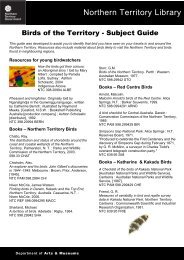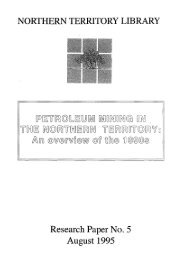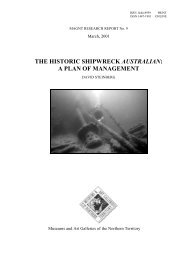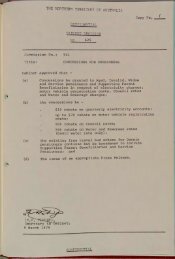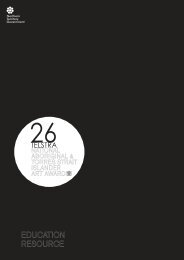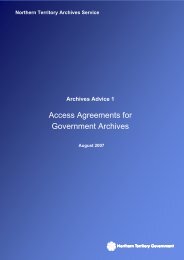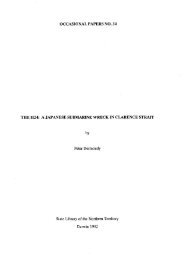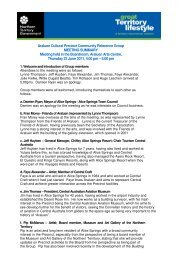ART AWARD - Department of Arts and Museums
ART AWARD - Department of Arts and Museums
ART AWARD - Department of Arts and Museums
Create successful ePaper yourself
Turn your PDF publications into a flip-book with our unique Google optimized e-Paper software.
25th NATSIAA Online Education Resource 2008<br />
SILVER JUBILEE<br />
telstra national aboriginal & torres strait isl<strong>and</strong>er<br />
<strong>ART</strong> <strong>AWARD</strong><br />
education resource<br />
Museum <strong>and</strong> Art Gallery Northern Territory www.magnt.nt.gov.au Conacher Street, Fannie Bay NT 0820<br />
1
25th NATSIAA Online Education Resource 2008<br />
SILVER JUBILEE<br />
telstra national aboriginal & torres strait isl<strong>and</strong>er<br />
<strong>ART</strong> <strong>AWARD</strong><br />
Introduction<br />
There are many intersecting themes throughout this exhibition <strong>and</strong> the artworks can be appreciated <strong>and</strong> discussed<br />
around a diverse selection <strong>of</strong> them.<br />
This kit focuses on four themes to stimulate thought <strong>and</strong> discussion on the 25th NATSIAA:<br />
1. Mortuary <strong>and</strong> Murder<br />
2. Caring for Country / Back to Country<br />
3. Oral History / Dreaming<br />
4. Politics / New Histories<br />
It complements previous NATSIAA education kits, which can be found on Museum <strong>and</strong> Art Gallery Northern<br />
Territory’s website, www.magnt.nt.gov.au. Previous kits exp<strong>and</strong> other thematic areas <strong>of</strong> research for teachers<br />
<strong>and</strong> students.<br />
The kit is for students from the Primary <strong>and</strong> Middle Years <strong>and</strong> can be used by both teachers <strong>and</strong> students. It<br />
supports the Northern Territory Curriculum Frameworks with suggested activities for The <strong>Arts</strong> Learning Area.<br />
A Children’s Activity booklet is available in hard copy for students from the Early Years.<br />
The aims <strong>of</strong> the kit are to:<br />
• stimulate thought <strong>and</strong> discussion on the 25th NATSIAA by both teachers <strong>and</strong> students,<br />
• encourage engagement <strong>and</strong> response using selected artworks,<br />
• introduce broad examples <strong>and</strong> perceptions <strong>of</strong> Indigenous art practices, <strong>and</strong><br />
• link themes <strong>and</strong> ideas in Australian Indigenous culture <strong>and</strong> art with those in mainstream Australia.<br />
Museum <strong>and</strong> Art Gallery Northern Territory www.magnt.nt.gov.au Conacher Street, Fannie Bay NT 0820<br />
2
25th NATSIAA Online Education Resource 2008<br />
Mortuary <strong>and</strong> Murder<br />
Death has been a common theme in the art <strong>of</strong> all cultures since ancient times.<br />
Loss <strong>of</strong> life not only causes grief <strong>and</strong> sorrow, at times almost unbearable, but it engenders a wide range <strong>of</strong> other<br />
powerful thoughts <strong>and</strong> associated evocative images in the bereaving family or culture. These may include anger,<br />
guilt, revenge, martyrdom, justice <strong>and</strong> injustice, <strong>and</strong> heroic deeds but, inevitably, ponderings about the afterlife are<br />
prominent, perhaps pivotal, in one’s coming to terms with death.<br />
Traditional cultures seek answers to questions <strong>of</strong> mortality/immortality through religious means, myth-making<br />
<strong>and</strong> storytelling. Art is the common mode <strong>of</strong> expressing cultural perceptions beyond the limitations <strong>of</strong> language.<br />
In contemporary societies science may appear to hold sway with its conclusions; starting with the ‘big bang’, then<br />
acceptance <strong>of</strong> Darwin’s theory <strong>of</strong> evolution <strong>and</strong> finally the search for ‘a theory <strong>of</strong> everything’. However, there is<br />
<strong>of</strong>ten a cold objectiveness that accompanies scientific revolutions. The human condition yearns for the elusive other<br />
dimension or quality missing from scientific equations. Consequently traditional views <strong>and</strong> customs, particularly<br />
relating to the meaning <strong>of</strong> life <strong>and</strong> the afterlife, are still strongly held <strong>and</strong> should not be denigrated as one would a ‘flat<br />
earth’ theory.<br />
The four examples in this section explore some <strong>of</strong> the views, customs <strong>and</strong> stories centred on death from an<br />
Indigenous Australian perspective.<br />
a. Robert Namarnyilk’s bark painting Mongerrk uses traditional pigments <strong>and</strong> design to tell a horrific<br />
Dreamtime story <strong>of</strong> murder, revenge <strong>and</strong> restitution. The Dreamtime story goes something like this:<br />
Mongerrk, the main figure in the painting, kills some women by biting them in two. He is then chased by<br />
two angry men who are outraged at his killing <strong>of</strong> their promised wives. The two men catch Mongerrk <strong>and</strong><br />
spear him to death <strong>and</strong> then burn his body. Afterwards the two men join the women’s severed bodies back<br />
together, bringing them back to life.<br />
b. Samson Bonson has created a lorrkon, or hollow-log c<strong>of</strong>fin, decorated with totemic designs that relate<br />
to the deceased. A hollow-log c<strong>of</strong>fin is a place to deposit the skeletal remains / bones <strong>of</strong> the deceased.<br />
In traditional Indigenous cultures throughout the Top End, the remains are placed in hollow logs after a<br />
sequence <strong>of</strong> mortuary ceremonies.<br />
c. Yidumduma Bill Harney has also created a hollow-log c<strong>of</strong>fin. Harney, from the southern part <strong>of</strong> Arnhem L<strong>and</strong>,<br />
has made a hollow-log c<strong>of</strong>fin quite different in appearance <strong>and</strong> production.<br />
d. Nawurapu Wunungmurra has created a series <strong>of</strong> carved <strong>and</strong> painted spirit figures. In a Western context you<br />
could think <strong>of</strong> these spirit figures as ghosts, supernatural figures or demons. Ghosts are strongly evocative<br />
<strong>and</strong> may engender fear or wonder.<br />
Primary Years 4–6<br />
At the exhibition: Response & Analysis<br />
• Use adjectives to describe one <strong>of</strong> the artworks mentioned above.<br />
• What is the purpose <strong>of</strong> a hollow-log c<strong>of</strong>fin <strong>and</strong> what is the equivalent in mainstream Australia<br />
• Look at Robert Namarnyilk’s painting on bark. What effect does he get from using a paintbrush made<br />
from a grass reed<br />
• Can you identify bones in Nawurapu Wunungmurra’s carved figures<br />
Museum <strong>and</strong> Art Gallery Northern Territory www.magnt.nt.gov.au Conacher Street, Fannie Bay NT 0820<br />
3
25th NATSIAA Online Education Resource 2008<br />
At school or at home: Creating Art Ideas, <strong>Arts</strong> Skills & Processes<br />
• Create your own hollow-log c<strong>of</strong>fin using card (cardboard rolls work well) or other materials <strong>and</strong> decorate it<br />
with a design meaningful to you. You could also make some little bones to go inside your log c<strong>of</strong>fin.<br />
• Experiment with painting by using grass, reeds or similar implements as paintbrushes. You may extend this<br />
to explore bark as a surface to paint on (remember not to damage any trees). You could also grind your own<br />
pigments <strong>and</strong> mix them with some wood glue to make paint.<br />
• Draw two pictures <strong>of</strong> a ghost. In the first draw a ghost as it would be represented in a movie or on<br />
television; in the second draw it as you think a ghost might look to you. Is there any difference between the<br />
two drawings<br />
• Use shadows to create artworks that explore the afterlife … these works usually have an ephemeral quality.<br />
Middle Years 7–9<br />
At the exhibition: Response & Analysis, <strong>Arts</strong> in Context<br />
• Respond to Robert Namarnyilk painting Mongerrk. How does the story make you feel What expressions do<br />
the figures in the painting have Are these similar to how you feel when you think about the painting’s story<br />
• Analyse Namarnyilk’s painting again. Can you think <strong>of</strong> any movies or television shows that deal with<br />
similar narratives<br />
• There are a number <strong>of</strong> hollow-log c<strong>of</strong>fins in the exhibition. Select the one you prefer <strong>and</strong> explain your choice.<br />
• Compare the ways your cultural background <strong>and</strong> that <strong>of</strong> Nawurapu Wunungmurra’s represent figures from<br />
the afterlife. What similarities <strong>and</strong> differences are there<br />
At school or at home: Creating Art Idea, <strong>Arts</strong> Skills & Processes<br />
• Using a variety <strong>of</strong> art-making techniques create a c<strong>of</strong>fin for your favourite animal.<br />
• Research the way other cultures deal with people who have passed away. Think about the funeral rituals<br />
in mainstream Australia.<br />
• Create your own paints from a variety <strong>of</strong> man-made sources like cooking oil, tinned beetroot, etc. You can<br />
also make your own brushes from man-made materials such as toothbrushes. Use these to make art.<br />
• View popular culture magazines <strong>and</strong> create a collage <strong>of</strong> images that deal with death. In addition you could<br />
create a list <strong>of</strong> songs that deal with the subject <strong>of</strong> death.<br />
Museum <strong>and</strong> Art Gallery Northern Territory www.magnt.nt.gov.au Conacher Street, Fannie Bay NT 0820<br />
4
25th NATSIAA Online Education Resource 2008<br />
Caring for Country / Back to Country<br />
Indigenous Australians have a unique relationship with the Australian l<strong>and</strong>scape. This relationship spans over 40,000<br />
years <strong>and</strong> has its genesis in the mythical Dreamtime. For Indigenous Australians, l<strong>and</strong> is not a commodity to be<br />
bought <strong>and</strong> sold; rather its ownership is based on customary law. The obligations to manage <strong>and</strong> care for country are<br />
generally passed down through paternal <strong>and</strong> maternal links.<br />
Recent Australian history has seen many changes in our relationship with l<strong>and</strong>. Many Indigenous Australians have<br />
been forced or drifted away from their homel<strong>and</strong>s to live in urban environments. ‘Caring for country’ is an important<br />
means for remaking connections that vitalised <strong>and</strong> maintained traditional l<strong>and</strong>s. Indigenous Australians, by either<br />
physically going back to country or through reminiscing <strong>and</strong> story-telling, are able to care for country. The caring<br />
involves not only the ecological aspects like fire <strong>and</strong> resource management but, perhaps more importantly, the<br />
reconnection with ancestors who reside in the l<strong>and</strong>scape <strong>and</strong> ancestral stories. Artists are well placed to care for<br />
country through the act <strong>of</strong> art-making. Artists, in depicting their country either naturalistically or on cultural terms,<br />
strengthen their bonds with the l<strong>and</strong>scape.<br />
a. Wentja Napaltjarri’s Country West <strong>of</strong> Kintore is a massive painting depicting her family’s traditional<br />
hunting grounds in the s<strong>and</strong>hills <strong>of</strong> that region. Napaltjarri paints her memories <strong>of</strong> hunting in the s<strong>and</strong>hills<br />
with her father. The painting is like a topographical map that gives a ‘bird’s-eye view’ <strong>of</strong> the country.<br />
b. Omborrin’s Gullaroonari – Munja Country is a place near Derby in the north <strong>of</strong> Western Australia. The<br />
artist has depicted the escarpments where ancestral W<strong>and</strong>jina who came to create country <strong>and</strong> law reside.<br />
c. Far Away Places by Angelina George is a painting <strong>of</strong> her homel<strong>and</strong> conceived from memory rather than<br />
from being there. The artist is reminiscing about her country <strong>and</strong> depicts it in a naturalistic manner.<br />
d. Nici Cumpston’s Nookamka Rushes – Lake Bonney is a photograph <strong>of</strong> a lake in South Australia. Fed by<br />
the Murray River, Lake Bonney is testimony to the devastation <strong>of</strong> the area by drought <strong>and</strong> government water<br />
policy. Cumpston is raising awareness by linking her ancestors to the ecology <strong>of</strong> the river country, aiming to<br />
protect both the river <strong>and</strong> her culture.<br />
Primary Years 4–6<br />
At the exhibition: Response & Analysis<br />
• Why do you think Nici Cumpston has taken a photograph <strong>of</strong> a lake with dead trees What purpose does this<br />
image serve<br />
• In what ways do you ‘care for country’<br />
• Napaltjarri <strong>and</strong> George both paint pictures <strong>of</strong> their homel<strong>and</strong>s; describe their different approaches. Here are<br />
some words to help: abstract, naturalistic, graphic <strong>and</strong> realistic.<br />
• How long is Wentja Napaltjarri’s painting You can carefully measure it by stepping out the length <strong>of</strong> the<br />
painting with your feet. What is the impact <strong>of</strong> such a massive painting<br />
Museum <strong>and</strong> Art Gallery Northern Territory www.magnt.nt.gov.au Conacher Street, Fannie Bay NT 0820<br />
5
25th NATSIAA Online Education Resource 2008<br />
At school or at home: Creating Art Ideas, <strong>Arts</strong> Skills & Processes<br />
• Design a poster to promote an environmental issue you feel strongly about.<br />
• Using chalk or some other appropriate medium find a suitable site <strong>and</strong> make the most massive drawing you<br />
can; try to break the world record!<br />
• Draw a map <strong>of</strong> Australia that features the Murray/Darling River systems.<br />
• From memory, paint a picture <strong>of</strong> a place you have visited.<br />
Middle Years 7–9<br />
At the exhibition: Response & Analysis, <strong>Arts</strong> in Context<br />
• What are some differences <strong>and</strong> similarities between the way Omborrin <strong>and</strong> Angelina George have painted<br />
their country<br />
• Look at Nici Cumpston’s photograph. What environmental issue is she documenting<br />
• Napaltjarri, Omborrin <strong>and</strong> George all paint their pictures from memory rather than life. Which other works in<br />
the exhibition are painted from memory <strong>and</strong> which are from life<br />
• Identify the different media used in Cumpston’s <strong>and</strong> George’s work. How does this difference influence the<br />
impact <strong>of</strong> the two works<br />
At school or at home: Creating Art Ideas, <strong>Arts</strong> Skills & Processes<br />
• Use images from popular culture to create a collage that highlights environmental issues.<br />
• Create an artwork that depicts your earliest memory <strong>of</strong> your home.<br />
• Research the benefits that Indigenous cultural practices have on the environment.<br />
• Look up other Australian artists with a European background <strong>and</strong> consider their treatment <strong>of</strong> the l<strong>and</strong>scape.<br />
Museum <strong>and</strong> Art Gallery Northern Territory www.magnt.nt.gov.au Conacher Street, Fannie Bay NT 0820<br />
6
25th NATSIAA Online Education Resource 2008<br />
Oral History / Dreaming<br />
Indigenous Australians use the expression ‘Dreamtime’ or ‘Dreaming’ to refer to ancestral times – the ‘time before<br />
time when all things were created’.<br />
Individuals also have a particular Dreaming or several Dreamings that are pertinent to them <strong>and</strong> their country; for<br />
example, someone may have ‘Crocodile Dreaming’.<br />
In the Dreamtime ancestral spirits formed the l<strong>and</strong>scape <strong>and</strong> its plants <strong>and</strong> animals; they established relationships<br />
between people <strong>and</strong> they created laws. Stories <strong>of</strong> the Dreamtime are h<strong>and</strong>ed down from generation to generation <strong>and</strong><br />
are integral to Indigenous culture. The maintenance <strong>and</strong> telling <strong>of</strong> Dreamtime stories can be through dance, music,<br />
story <strong>and</strong> visual art.<br />
In contrast to the Dreamtime, which deals with ancestral history, ‘oral history’ is a term that refers to more<br />
recent events in living memory. Both the Dreaming <strong>and</strong> oral history feature strongly in contemporary Indigenous art<br />
practices.<br />
a. Graham Taylor’s Mission Boy is about a mission where he stayed in the 1960s. Many young Indigenous<br />
Australians were removed to missions in an effort to assimilate them. Taylor’s painting tells his own story as<br />
a boy being punished after trying to run away from the mission.<br />
b. George Dangi’s Wagilag Story is a figurative work set in the Dreamtime when two sisters travelled through<br />
Arnhem L<strong>and</strong> creating customs.<br />
c. Harts Range Rodeo Rider by Dinni Kunoth Kemarre is a painted carving. Kemarre is showing us an<br />
everyday story with which he has great affinity. Aboriginal people have a strong connection with horses from<br />
pastoralist <strong>and</strong> stockmen times.<br />
d. Jean Baptiste Apuatimi’s Jirtaka (sawfish) is a bold painting <strong>of</strong> a series <strong>of</strong> fishbones. The artist is<br />
referencing both her family <strong>and</strong> the Dreamtime.<br />
Primary Years 4–6<br />
At the exhibition: Response & Analysis<br />
• Find the marks under the window in Graham Taylor’s painting. The marks show where he tried to escape from<br />
the mission.<br />
• Count how many figures there are in George Dangi’s painting.<br />
• What do the tall things in Jean Baptiste’s painting remind you <strong>of</strong> For the artist they are fishbones.<br />
• What is the difference between the two surfaces that George Dangi <strong>and</strong> Jean Baptiste have painted on<br />
Museum <strong>and</strong> Art Gallery Northern Territory www.magnt.nt.gov.au Conacher Street, Fannie Bay NT 0820<br />
7
25th NATSIAA Online Education Resource 2008<br />
At school or at home: Creating Art Ideas, <strong>Arts</strong> Skills & Processes<br />
• Collect some bones <strong>and</strong> draw them. Keep in mind government regulations concerning the collection <strong>of</strong> native<br />
species. Fish or chicken bones from your dinner are good.<br />
• Using a cartoon format create an artwork that tells a personal story.<br />
• Using collage as a technique make an artwork about rodeos.<br />
• Use found materials to create a sculptural form <strong>of</strong> an animal.<br />
Middle Years 7–9<br />
At the exhibition: Response & Analysis, <strong>Arts</strong> in Context<br />
• Read the wall label for George Dangi’s painting to find out more about the Dreamtime story it depicts.<br />
• From the four works in this section choose the one you prefer <strong>and</strong> share your opinion.<br />
• Identify female artists in the NATSIAA exhibition. What is the ratio <strong>of</strong> male to female artists<br />
• Find examples <strong>of</strong> artworks that deal with ancient Dreamtime stories <strong>and</strong> with everyday stories.<br />
At school or at home: Creating Art Ideas, <strong>Arts</strong> Skills & Processes<br />
• Explore art-making by carving into wood; this will need to be a planned <strong>and</strong> supervised activity. Look at Dinni<br />
Kunoth Kemarre for inspiration.<br />
• Research <strong>and</strong> find other cultures that have parallel stories to the Dreamtime, expressing the ‘time before<br />
time when all things were created’. Noah’s Ark is a good example from Christian mythology.<br />
• Choose <strong>and</strong> research a Dreamtime story in depth.<br />
• Looking at Graham Taylor’s painting you can see he has made marks to show where he tried to escape. Using<br />
this idea create marks that show how you might escape from something.<br />
Museum <strong>and</strong> Art Gallery Northern Territory www.magnt.nt.gov.au Conacher Street, Fannie Bay NT 0820<br />
8
25th NATSIAA Online Education Resource 2008<br />
Politics / New Histories<br />
Most art from around the world can be seen as a commentary on society. Art historians look to art for insight into<br />
past societies. Some artists chose to use their art specifically for social commentary <strong>and</strong> this art can be critiqued<br />
as political art. Indigenous Australians are affected by many new issues that have arisen since the European arrival<br />
in Australian. These issues can be referred to as ‘new histories’ <strong>and</strong> include degradation <strong>of</strong> tribal structures, loss <strong>of</strong><br />
language, environmental damage, l<strong>and</strong>-rights, stolen generations, the impact <strong>of</strong> Western diseases, <strong>and</strong> deaths<br />
in custody.<br />
a. Bindi Cole’s How to be a Domestic Goddess is from a series <strong>of</strong> photographic works capturing the<br />
transformation <strong>of</strong> a man to a drag queen. The subject <strong>of</strong> this work is identity.<br />
b. Untitled from the Psalm Singing Suite by artist Richard Bell uses the notions <strong>of</strong> pop art to create a<br />
direct political message in response to events on Palm Isl<strong>and</strong>, Queensl<strong>and</strong>, in 2004.<br />
c. Suzy Evans has made an installation called Bengerang comprising about 60 posts. The artist is interested<br />
in the notion <strong>of</strong> the outlaw such as Ned Kelly or Robin Hood. Here she has placed the Aboriginal as outlaw<br />
amongst many.<br />
d. Danie Mellor’s Exotic lies <strong>and</strong> Sacred ties … is an installation about the colonising <strong>of</strong> Australia by<br />
Europeans in the 18th century <strong>and</strong> the associated issues. Mellor’s work employees a variety <strong>of</strong> techniques<br />
<strong>and</strong> references; it is on one level very funny <strong>and</strong> on another very serious.<br />
Primary Years 4–6<br />
At the exhibition: Response & Analysis<br />
• What is the full title <strong>of</strong> Danie Mellor’s artwork<br />
• What type <strong>of</strong> art style has influenced Richard Bell<br />
• Describe similarities between Danie Mellor’s <strong>and</strong> Suzy Evans’ artworks.<br />
• Can you find the Ned Kelly in Suzy Evans’ work (I can’t.)<br />
At school or at home: Creating Art Ideas, <strong>Arts</strong> Skills & Processes<br />
• Find out who Ned Kelly was.<br />
• Create an artwork that is an installation; remember it does not have to be massive to be successful.<br />
• Richard Bell’s style is strongly influenced by pop art. Use this art style to create your own artwork.<br />
• Explore cardboard as a material from which to make art.<br />
Museum <strong>and</strong> Art Gallery Northern Territory www.magnt.nt.gov.au Conacher Street, Fannie Bay NT 0820<br />
9
25th NATSIAA Online Education Resource 2008<br />
Middle Years 7–9<br />
At the exhibition: Response & Analysis, <strong>Arts</strong> in Context<br />
• Identify the various materials in Danie Mellor’s installation.<br />
• From the four examples above match the theme <strong>of</strong> the work from the following choices: deaths in custody,<br />
drought, colonisation <strong>and</strong> gender.<br />
• Identify other artworks in the exhibition that have a clear political message.<br />
• Bindi Cole’s photograph is a good example <strong>of</strong> a contemporary Indigenous artwork that uses a non-traditional<br />
subject <strong>and</strong> techniques. Find other contemporary artworks in the exhibition.<br />
At school or at home: Creating Art Ideas, <strong>Arts</strong> Skills & Processes<br />
• Both Suzy Evans <strong>and</strong> Danie Mellor have created installations. Write a definition <strong>of</strong> ‘installation art’.<br />
• Research the story behind Richard Bell’s painting. Here is a clue … Palm Isl<strong>and</strong>, November 2004.<br />
• Choose a political issue that is important to you <strong>and</strong> create an artwork that highlights the issue.<br />
• Choose an artwork you relate to aesthetically <strong>and</strong> create an artwork in a similar style <strong>and</strong> technique.<br />
Museum <strong>and</strong> Art Gallery Northern Territory www.magnt.nt.gov.au Conacher Street, Fannie Bay NT 0820<br />
10
25th NATSIAA Online Education Resource 2008<br />
SILVER JUBILEE<br />
telstra national aboriginal & torres strait isl<strong>and</strong>er<br />
<strong>ART</strong> <strong>AWARD</strong><br />
images<br />
Museum <strong>and</strong> Art Gallery Northern Territory www.magnt.nt.gov.au Conacher Street, Fannie Bay NT 0820<br />
11
25th NATSIAA Online Education Resource 2008<br />
Mortuary <strong>and</strong> murder<br />
a<br />
b<br />
c<br />
d<br />
Museum <strong>and</strong> Art Gallery Northern Territory www.magnt.nt.gov.au Conacher Street, Fannie Bay NT 0820<br />
12
25th NATSIAA Online Education Resource 2008<br />
Caring for Country / Back to Country<br />
a<br />
b<br />
c<br />
d<br />
Museum <strong>and</strong> Art Gallery Northern Territory www.magnt.nt.gov.au Conacher Street, Fannie Bay NT 0820<br />
13
25th NATSIAA Online Education Resource 2008<br />
Oral History / Dreaming<br />
a<br />
b<br />
c<br />
d<br />
Museum <strong>and</strong> Art Gallery Northern Territory www.magnt.nt.gov.au Conacher Street, Fannie Bay NT 0820<br />
14
25th NATSIAA Online Education Resource 2008<br />
Policies / New Histories<br />
a<br />
b<br />
c<br />
d<br />
Museum <strong>and</strong> Art Gallery Northern Territory www.magnt.nt.gov.au Conacher Street, Fannie Bay NT 0820<br />
15




